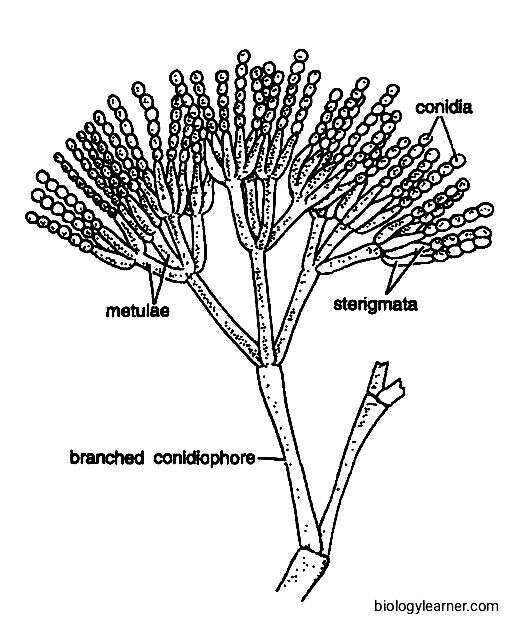Penicillium is a saprophytic fungus of the class Plectomycetes. It is found in all parts of the world.
The name penicillium is derived from the Latin word penicillus, which means artist’s brush. As the structure of its conidiophore resembles that of the artist’s brush.
Some species of Penicillium produce penicillin, an antibiotic used for the treatment of gram-positive bacteria.
In 1929, Sir Alexander Fleming accidentally discovered penicillin. He was working on the bacterium Staphylococcus aureus, and his culture got contaminated by mould spores (Penicillium notatum). After proper growth, P. notatum caused the death of the bacterium and showed a lytic zone around itself. Fleming then isolated the antimicrobial compound, which he called penicillin.
Penicillium is commonly known as blue or green mould as it produce a mass of bluish, greenish or yellowish spores. These spores are found everywhere in the air and soil.

Occurrence of Penicillium
Penicillium is a genus of about 354 species. It occurs throughout the world.
The majority of the species are saprophytes, usually growing on decaying fruits and vegetables. Some species also occur on preserved fruits and jellies.
Penicillium chrysogenum (previously known as P. notatum) prefers to grow in indoor environments, especially damp or water-damaged buildings.
Species of Penicillium can also be found on moist forest floors and damp woods.
- Some Penicillium species are: P. commune, P. glabrum, P. ulaiense, P. chrysogenum, P. albocoremium, P. verrucosum, P. lusitanum, P. expansum, P. digitatum, P. roqueforti, etc.

Vegetative Structure of Penicillium
The vegetative plant body of Penicillium is a well-developed, profusely branched mycelium. The mycelium consists of slender, tubular, hyaline, branched, septate hyphae.
The hyphae grow superficially on the surface of the substratum. They intertwined with one another, forming a cottony net-like appearance.

Some hyphae, called haustorial hyphae, penetrate deep into the substratum to absorb the food materials.
The hyphal cells are uninucleate or multinucleate. Each cell has a thin, microfibrillar cell wall that surrounds the granular cytoplasm.
Many cellular organelles, such as mitochondria, endoplasmic reticulum, ribosomes, vacuoles, etc., are present in the cytoplasm. The reserve food material is in the form of oil globules.
The cytoplasm of the adjacent cells remains continuous through a small central pore in each septum.
Read also- Ascobolous: Occurrence, Structure, Reproduction
Reproduction in Penicillium
Penicillium reproduces vegetatively, asexually, and sexually.
Vegetative Reproduction
Vegetative reproduction in Penicillium occurs mainly through fragmentation.
The vegetative mycelium breaks up into two or more fragments due to accidental breakage. Each fragment develops into a new mycelium under favourable conditions.
In some species, the mycelium often forms compact resting bodies called sclerotia (Srivastava, 1962).
The sclerotia contain sufficient food reserves and can remain dormant until suitable conditions return.
With the onset of suitable environmental conditions, each sclerotium germinates into a new mycelium of Penicillium.
